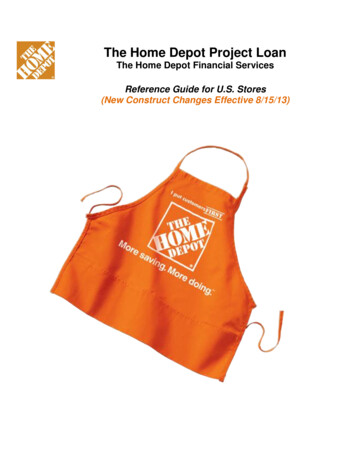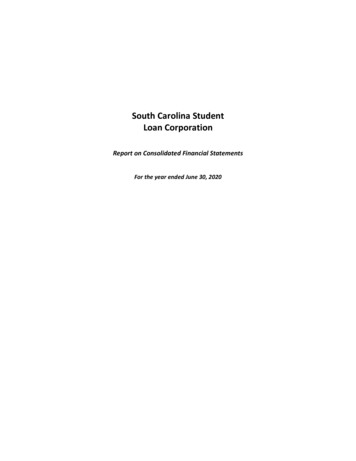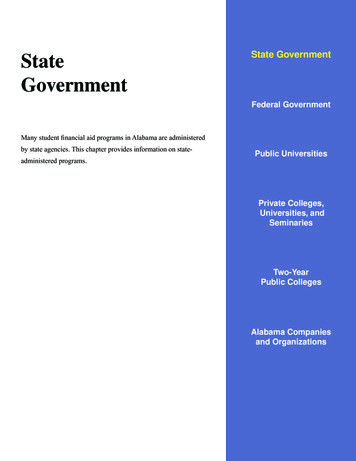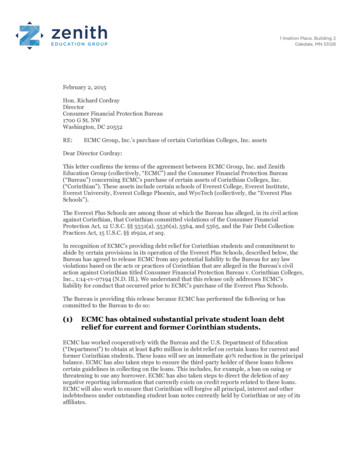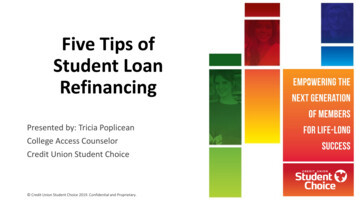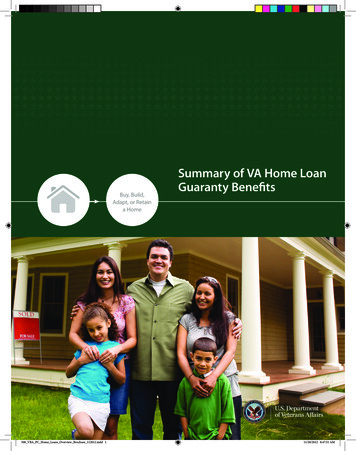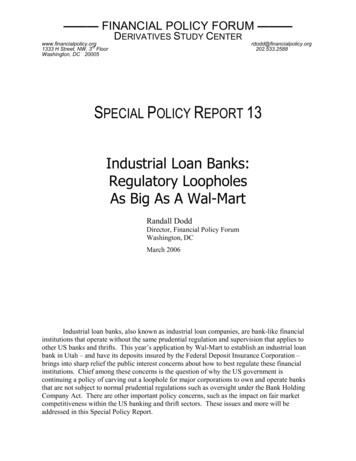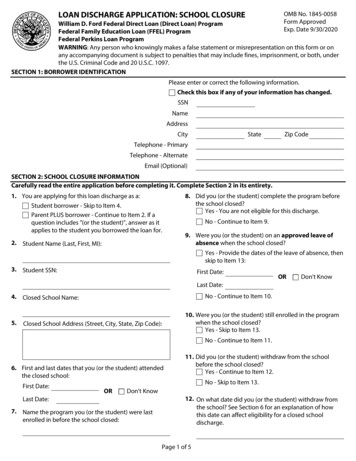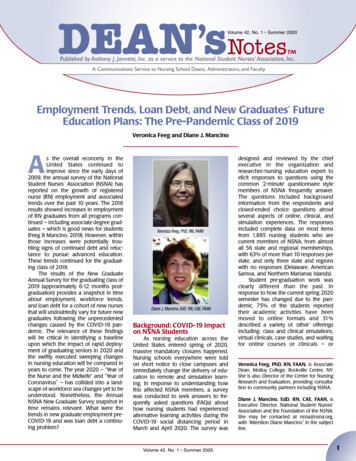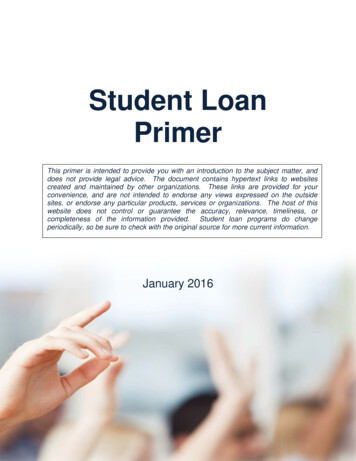
Transcription
Student LoanPrimerThis primer is intended to provide you with an introduction to the subject matter, anddoes not provide legal advice. The document contains hypertext links to websitescreated and maintained by other organizations. These links are provided for yourconvenience, and are not intended to endorse any views expressed on the outsidesites, or endorse any particular products, services or organizations. The host of thiswebsite does not control or guarantee the accuracy, relevance, timeliness, orcompleteness of the information provided. Student loan programs do changeperiodically, so be sure to check with the original source for more current information.January 2016
TABLE OF CONTENTSI.Types of Student Loans . 1A. Federal Student Loans . 1B. Private Student Loans . 3II.Repayment Options for Federal Student Loans . 4A. Consolidation . 4B. Loan Rehabilitation . 4C. Standard . 5D. Graduated . 5E. Extended . 5F. Deferment or Forbearance . 5G. Income-Contingent Repayment Program (“ICR”) . 6H. Income-Based Repayment Plan (“IBR”) . 6I. Pay as You Earn (PAYE) . 7J. Revised Pay as You Earn (REPAY) .7K. Income-Sensitive Repayment Plan (ISRP) . 7III.Specialized Loan Forgiveness Programs and Non-Bankruptcy Discharges forFederal Student Loans . 8A. Total and Permanent Disability (TPD) . 8B. Public Service Loan Forgiveness Program for Direct Loans . 9C. Public Service Loan Forgiveness Program for Perkins Loans . 10D. Teacher Loan Forgiveness Program . 10E. False Certification Discharge . 11F. Unpaid Refund Discharge . 12G. Death Discharge . 12H. Military Service Discharge . 13I. September 11 Survivors Discharge. 14J. Closed School Discharge . 14IV.Bankruptcy Undue Hardship Discharge . 15i
APPENDIX TO STUDENT LOAN PRIMERAppendix A – Student Loan GlossaryAppendix B – Federal Perkins Loan Contact InformationAppendix C – Health Education Assistance Loan (HEAL) Program Contact InformationAppendix D – Student Loan Servicers Contact ListAppendix E – Student Loan State Guaranty Agencies Contact Listii
I.Types of Student LoansA basic understanding of the different types of loans is critical. There are federalstudent loans and private student loans. Different laws and regulations apply to thedifferent loan types, and the way you obtain information about your loans andrepayment options varies depending on the type.A.Federal Student LoansFederal education loans have been available either through the William D. FordFederal Direct Loan Program ("Direct Loans") or the Federal Family Education LoanProgram ("FFEL Program" or "FFELP").The Direct Loan Program has been the only source for federally-funded studentloans since late 2010. These student loans are funded directly from the US Treasury.The federal government is authorized to make several types of direct loans at specifiedinterest rates: Subsidized and Unsubsidized Stafford, Perkins, PLUS and ConsolidationLoans. See 20 U.S.C. § 1087e (describing the terms and conditions of the federaldirect loan program). These types are discussed in more depth later in this primer.The FFEL Program was discontinued in mid-2010, but many borrowers still haveoutstanding FFEL student loans. FFEL loans were funded by private lenders. Thefederal government guaranteed FFEL loans, so it reimburses a private lender when aborrower defaults. The FFEL Program is sometimes referred to as the federallyguaranteed student loan program. FFELs often confused with private loans, but theyshould be considered as federal student loans.The choice of loan programs available to a borrower depends on the college theyattend. Borrowers had their choice of lenders in the FFEL program, but not in the DirectLoan program.1.Subsidized StaffordThe Subsidized Stafford loan offers the lowest interest rate. Borrowers mustmeet a financial needs test to qualify. Graduate and professional students are noteligible for these loans.2.Unsubsidized StaffordUnsubsidized Stafford loans are made without regard to financial need.3.PerkinsThe schools that participate in the Perkins Loan program select the students whoare eligible to receive these favorable loans from a limited pool of funds made availableby the government. The student borrowers must prove financial need. The interest rate
on these loans is set at a relatively low 5% rate, and is paid by federal government whilethe student is enrolled in school.4.PLUSPLUS Loans (Parents Plus) are available to parents with dependantundergraduate, graduate, and professional degree students. PLUS Loan applicantsmay not have any adverse credit history.5.Consolidation LoansConsolidation Loans are available for borrowers with existing federal studentloans (Direct or FFEL) in order to combine the loans and extend payment schedulesand terms. A borrower’s existing loans are paid off and a new consolidation loan iscreated. Although the monthly payment amount on a consolidation loan usually is lowerthan for the combined existing loans, this benefit comes at the price of a longerrepayment period.Interest rates for these loans currently are fixed, but have historically been pricedat a spread to Treasury bills. Whether based on a fixed or variable rate, the interestrate does not reflect the borrower’s risk – if the borrower is eligible for a loan, he or shewill be charged the same rate as any other eligible borrower.6.Obtaining Information About Federal Student LoansThe federal government, through the United States Department of Education(“ED”), maintains a website through which every federal student loan borrower canobtain critical information. It is the starting point for most student loan borrowers whoare researching their payment options because options depend on the types of loans,and borrowers need to know the identity of their lenders and loan servicers.National Student Loan Data System (“NSLDS”) is a database that containsinformation, including chain of custody, interest rate, loan type, loan status, etc.,regarding every federal student loan a person has borrowed. Lenders, servicers, andguarantors have access to borrower NSLDS reports if they hold the loan. Privatestudent loans are not included in the NSLDS database and must be researchedseparately.Borrowers may access their own NSLDS reports by going to www.nslds.ed.gov.They must first obtain a PIN at www.pin.ed.gov. NSLDS is available 24/7, withoccasional downtime for maintenance. For help, you may call the Federal Student AidInformation Center at 1-800-4-FED-AID/TDD 1-800-730-8913, which is available 8AM to10PM (Eastern Time), Monday through Friday, except federal holidays.2
Here is an example of the information accessible through NSLDS for ahypothetical borrower’s student loans:The types of loans included in the NSLDS database are:FFEL ConsolidatedDirect Stafford SubsidizedDirect Stafford Subsidized (SULA Eligible)Direct Stafford UnsubsidizedDirect PLUS for Graduate or Professional StudentsDirect PLUSDirect Consolidated UnsubsidizedDirect Consolidated SubsidizedDirect Consolidated Subsidized (SULA Eligible)Direct PLUS ConsolidatedDirect Unsubsidized TEACH LoanNational Defense LoanPerkins Expanded LendingFederally Insured Student Loan—FISLFFEL PLUS for Graduate or Professional StudentsIncome Contingent Loan—ICLNational Direct Student Loan—NDSLFFEL PLUSFederal PerkinsFFEL RefinancedFFEL Stafford SubsidizedSupplemental Loan—SLSFFEL Stafford UnsubsidizedNote that if you have been making payments on a loan, the outstanding principalbalance listed by NSLDS may be as much as 120 days old. You can contact the loanservicer for more up-to-date balance information. Contact information for servicersappears at the end of this document.B.Private Student LoansIn additional to federal education loans, private lenders (banks and otherfinancial institutions) also loan money to students. A student might take out a nonfederal loan if he has reached the annual or aggregate federal loan cap.Unlike federal student loans, most non-federal loans are priced according tocreditworthiness standards, resulting in higher (and sometimes variable) interest rates.There is no cap under federal law on interest rates for student loans from private3
lenders. Typically, private lenders will require a student borrower to have a co-borroweron the loan.Although private lenders may offer some loan consolidation options, they are notrequired to and generally do not offer the types of repayment options, discharge orforgiveness programs that exist for federal student loans.Since 2005, private student loans that fit the federal definition of “qualifiededucation loans” are presumed to be nondischargeable in a bankruptcy case, just aswith federal student loans.More information about private student loans can be found phtml1.Obtaining Information About Private Student LoansPrivate loans will not appear on the NSLDS website database, which ismaintained only for federal student loans. While there is no centralized source ofinformation just for student loans, these loans may appear on the borrower’s creditreport. Find more information about credit reports and how to obtain yours at rt.com/index.actionII.Repayment Options for Federal Student LoansA.Consolidation Technically a new loan, but can lower payments Benefits by spreading out the payments New consolidation loans available only through Direct Loan Program Can consolidate defaulted FFEL loans into Direct Loan Program Parent PLUS loans should not be included in consolidated loan if borrowerplanning to use income-driven repayment plansB.Loan Rehabilitation Defaulted borrowers may receive a one-time chance to bring loans out ofdefault Payments based on a “reasonable rate”4
C. Nine on time payments over a ten month period Restore loans to pre-default status, reestablish eligibility for deferment,forbearance, alternative repayments, Title IV aid, credit reportrehabilitation.StandardA standard repayment plan is the default schedule for federal student loansunless the borrower is eligible for and takes action to select another option. Standardmonthly payments are for a fixed amount, and will be spread over 10 years (or between10 and 30 years for consolidation loans).This repayment plan saves you money over time because your monthlypayments may be slightly higher than payments made under other plans, but you’ll payoff your loan in the shortest time. For this reason, you will pay the least amount ofinterest over the life of your loan.For more information see: ans/standardD.GraduatedIf your income is low now, but you expect it to increase steadily over time, agraduated repayment plan may be right for you. This plan starts with lower paymentsthat increase every two years. Payments are made for up to 10 years (or between 10and 30 years for consolidation loans).For more information see: ans/graduatedE.ExtendedThe extended repayment plan allows you to repay your loans over an extendedperiod of time (longer than may be available under the standard or graduated plan) andwithout having to consolidate your loans if that is not the right choice for you. Extendedrepayment plans last for up to 25 years.For more information see: ans/extendedF.Deferment or ForbearanceDeferment is a postponement of payment on a loan that is allowed under certainconditions and during which interest does not accrue on Direct Subsidized Loans,Subsidized Federal Stafford Loans, and Federal Perkins Loans. All other federal studentloans that are deferred will continue to accrue interest. Any unpaid interest that accruedduring the deferment period may be added to the principal balance (capitalized) of the5
loan. An example of a condition that may allow deferment is when the student borroweris enrolled at least half-time in college or career school or
National Direct Student Loan—NDSL . FFEL PLUS . Federal Perkins . FFEL Refinanced . FFEL Stafford Subsidized . Supplemental Loan—SLS . FFEL Stafford Unsubsidized . Note that if you have been making payments on a loan, the outstanding principal balance listed by NSLDS may be as much as 120 days old. You can contact the loan servicer for more upto-date balance information. Contact .

